Stripe Bundle
Who Really Owns Stripe?
Unraveling the ownership of a financial powerhouse like Stripe is key to understanding its future. From its humble beginnings to its current valuation of $91.5 billion, Stripe's ownership has evolved significantly. This deep dive explores the key players and pivotal moments that have shaped the company's trajectory.
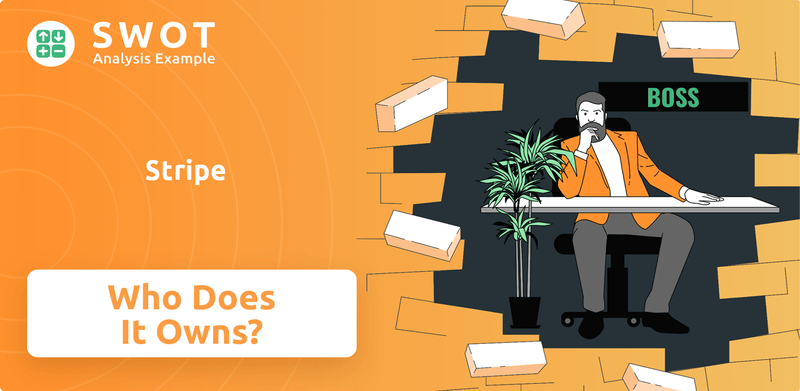
Founded by the Collison brothers, Stripe's journey from a payment processing startup to a global financial infrastructure platform is fascinating. Understanding the Stripe SWOT Analysis can provide further insights into the company's strategic direction. This article will explore the company's ownership structure, including the Stripe founders, key investors, and how these stakeholders influence the company's decisions. Discover who owns Stripe and gain a comprehensive understanding of this dynamic company.
Who Founded Stripe?
The story of Stripe begins with the Irish brothers John and Patrick Collison, who founded the company in 2010. They remain key figures, with Patrick Collison as CEO and John Collison as President. Understanding the initial ownership structure is crucial for anyone looking into the company's history and current dynamics.
As co-founders, the Collison brothers hold significant stakes in Stripe, influencing its direction and strategy. While the exact initial equity split isn't public, their roles highlight their continued commitment and control. This setup is typical for tech startups, where founders often maintain substantial ownership to guide the company's growth.
Early investment played a pivotal role in Stripe's journey. In 2011, the company secured a $2 million investment, which included contributions from notable angel investors such as Elon Musk and Peter Thiel. Venture capital firms like Sequoia Capital, Andreessen Horowitz, and SV Angel also participated, setting the stage for future funding rounds.
John and Patrick Collison founded Stripe in 2010. Patrick Collison is the CEO, and John Collison is the President.
Early investors included Elon Musk, Peter Thiel, Sequoia Capital, and Andreessen Horowitz. These investments helped fuel Stripe's initial growth.
Founder stock is typically subject to a 4-year vesting schedule. This means that shares vest over time, encouraging long-term commitment.
Dilution occurs as new shares are issued, but the goal is to increase the company's overall value. A smaller percentage of a successful company can be worth more.
Patrick Collison as CEO and John Collison as President. They play crucial roles in the company's leadership and decision-making.
Founders typically retain a significant stake in the company. The exact initial equity splits for the founders are not publicly disclosed.
Understanding the Stripe ownership structure involves looking at the founders, early investors, and subsequent funding rounds. The Collison brothers remain central to who owns Stripe. Early investment from key players like Sequoia Capital and Andreessen Horowitz helped shape the company. The Stripe company owner structure has evolved through multiple funding rounds, with the founders and early investors maintaining significant influence. For a deeper dive into Stripe's target market, check out this article: Target Market of Stripe.
- The Collison brothers are the key founders.
- Early investors included Elon Musk and Peter Thiel.
- Venture capital firms like Sequoia Capital were early backers.
- Founders typically have a 4-year vesting schedule.
Stripe SWOT Analysis
- Complete SWOT Breakdown
- Fully Customizable
- Editable in Excel & Word
- Professional Formatting
- Investor-Ready Format
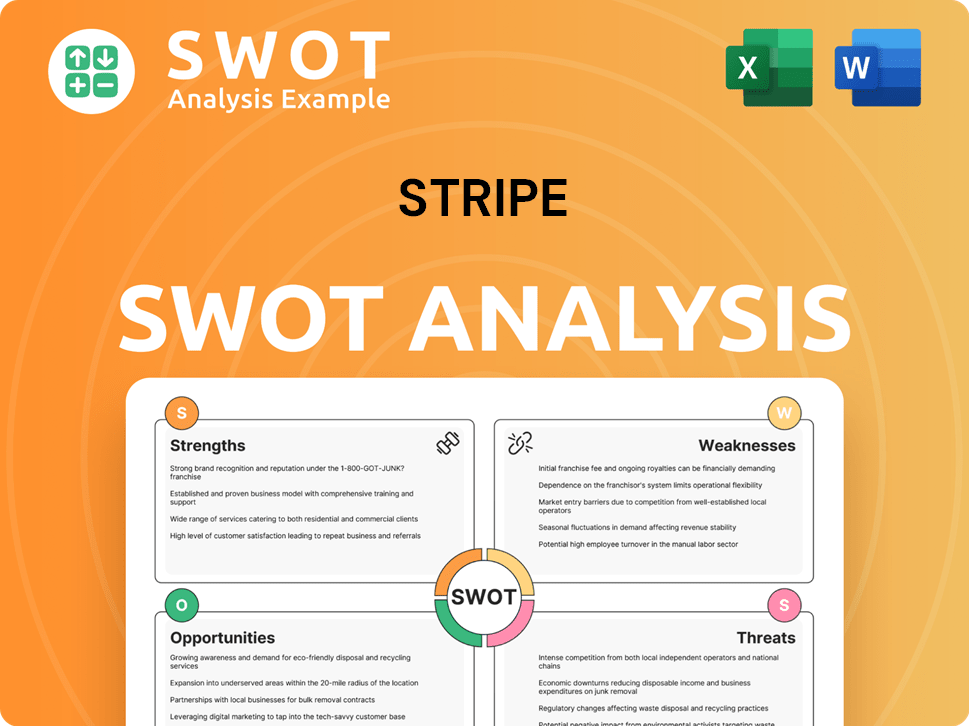
How Has Stripe’s Ownership Changed Over Time?
The ownership structure of Stripe, a privately held company, has evolved significantly since its inception. This structure has allowed Stripe to maintain control over its operations while attracting substantial investment from prominent venture capital firms and strategic investors. The company's journey, from its early funding rounds to recent secondary market transactions, reflects its growth and strategic shifts. Understanding the evolution of Stripe ownership is crucial for grasping its strategic direction and market position.
Key events have shaped the Stripe company owner landscape. Initial investments from Sequoia Capital, Andreessen Horowitz, and Founders Fund were pivotal. In March 2021, Stripe raised $600 million in its Series H round, reaching a valuation of $95 billion. The company then secured over $6.5 billion in March 2023 during its Series I round, primarily to provide liquidity to employees, which valued Stripe at $50 billion. More recently, in April 2024, a secondary market transaction raised $694.2 million, increasing the valuation to $65 billion. A February 2025 tender offer further reshaped ownership, with a $91.5 billion valuation, bringing it close to its 2021 peak. To learn more about the company's beginnings, you can read a Brief History of Stripe.
| Event | Date | Valuation |
|---|---|---|
| Series H Funding Round | March 2021 | $95 billion |
| Series I Funding Round | March 2023 | $50 billion |
| Secondary Market Transaction | April 2024 | $65 billion |
| Tender Offer | February 2025 | $91.5 billion |
The current major stakeholders in Stripe include its founders, Patrick and John Collison, along with venture capital firms like Sequoia Capital, Andreessen Horowitz, and Founders Fund. Additional significant investors include Fidelity, Thrive Capital, General Catalyst, MSD Partners, GIC, Goldman Sachs Asset Management, and Temasek. This diverse group of Stripe investors supports the company's ongoing investments in research and development, particularly in emerging technologies such as stablecoins and AI. The ownership structure of Stripe continues to evolve, reflecting its growth and strategic priorities.
Stripe remains privately held, allowing for strategic control and flexibility.
- Early investors included Sequoia Capital and Andreessen Horowitz.
- Recent valuations have fluctuated, with a notable rebound in 2025.
- The Collison brothers, along with venture capital firms, are key stakeholders.
- Significant investments continue in research and development.
Stripe PESTLE Analysis
- Covers All 6 PESTLE Categories
- No Research Needed – Save Hours of Work
- Built by Experts, Trusted by Consultants
- Instant Download, Ready to Use
- 100% Editable, Fully Customizable
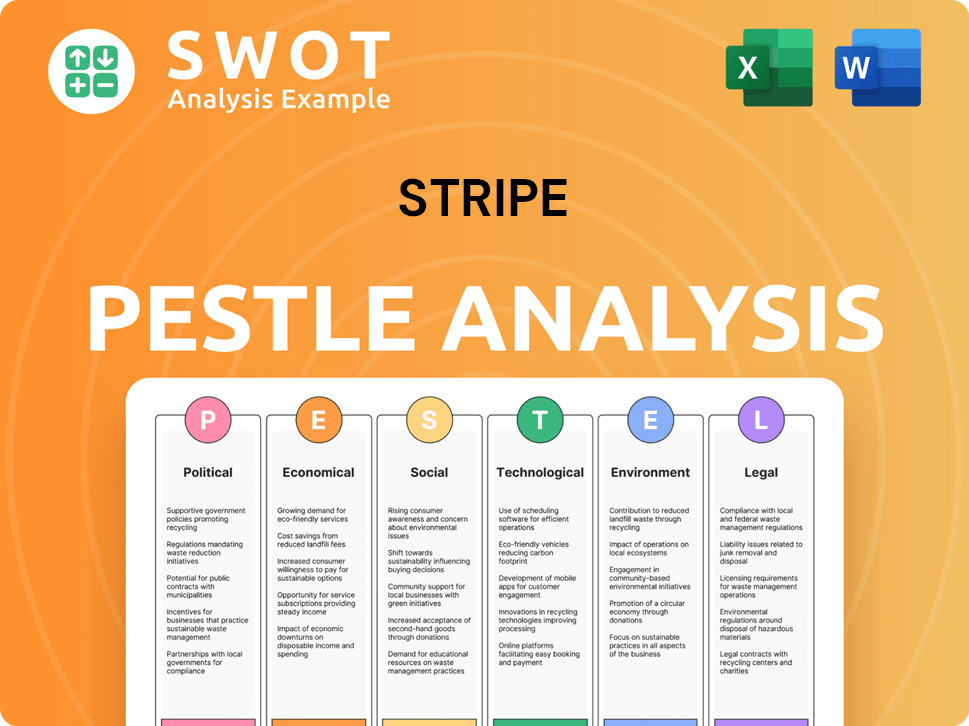
Who Sits on Stripe’s Board?
As a privately held entity, the specifics of the board of directors for the payment processing giant are not publicly available in the same way as for publicly traded companies. However, it's widely understood that the co-founders, Patrick and John Collison, remain central to the company's governance and strategic decisions. The exact composition of the board and the specific roles of each member are not disclosed, but it is likely that key investors and industry experts are included to provide guidance and oversight.
In the context of private companies like this, the board typically includes representatives from major venture capital firms and other significant investors. These representatives help to protect their investments and provide strategic direction. The structure of the board and the voting rights are governed by agreements among the shareholders and board members, reflecting the private nature of the company. This structure is designed to facilitate effective governance and strategic decision-making, tailored to the company's specific needs and growth trajectory.
| Board Member | Role | Notes |
|---|---|---|
| Patrick Collison | Co-founder & CEO | Leads the company's vision and strategy. |
| John Collison | Co-founder & President | Focuses on product and engineering. |
| Investor Representatives | Board Members | Represent major investors, providing strategic guidance. |
The ownership structure of Stripe, like other private companies, involves different classes of shares and agreements that grant specific voting rights. Even as funding rounds dilute the founders' ownership, they often retain significant control. Preferred stock issued to investors often includes additional rights, such as priority in dividends and assets during liquidation, and sometimes anti-dilution protections. This structure helps to balance the interests of founders, investors, and the overall strategic direction of the company. For more details about the company's history, you can read an article about Stripe's payment platform.
The Collison brothers, as founders, hold significant influence over Stripe's decisions.
- Major investors have board representation, guiding strategy.
- Voting rights are defined by agreements among shareholders.
- The company's value was estimated at around $65 billion in early 2024.
- Stripe's headquarters are located in San Francisco, California.
Stripe Business Model Canvas
- Complete 9-Block Business Model Canvas
- Effortlessly Communicate Your Business Strategy
- Investor-Ready BMC Format
- 100% Editable and Customizable
- Clear and Structured Layout
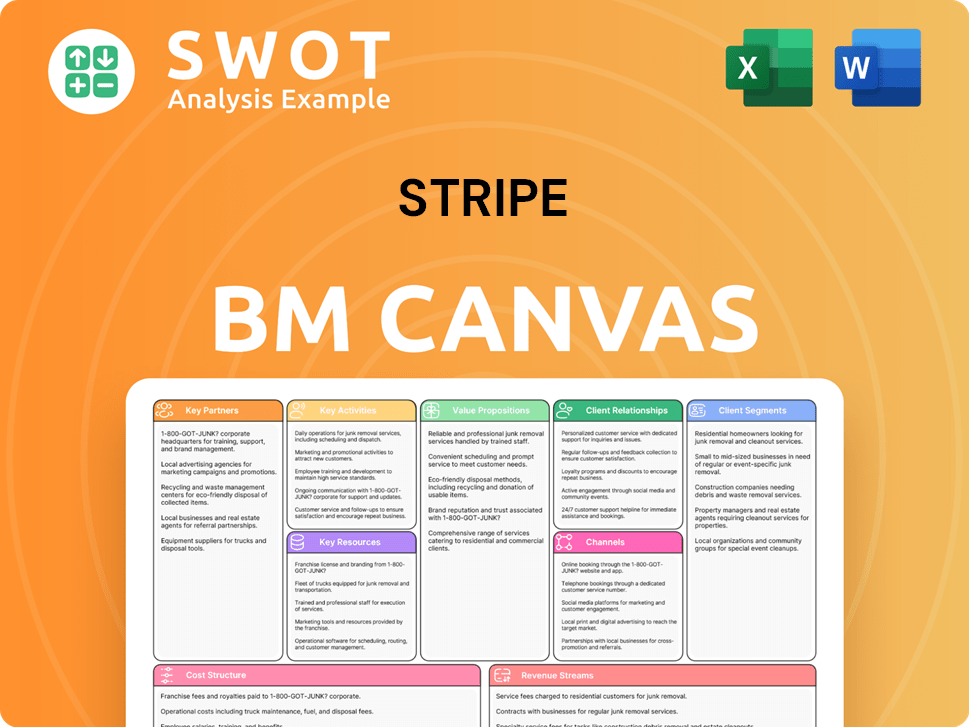
What Recent Changes Have Shaped Stripe’s Ownership Landscape?
Recent developments in Stripe ownership show a focus on providing liquidity to existing stakeholders. Over the past three to five years, the company has prioritized funding rounds and tender offers. These actions provide opportunities for employees and early investors to realize value. The Series I fundraise in March 2023, which raised $6.5 billion, and subsequent tender offers in April 2024 and February 2025, reflect this trend.
The February 2025 tender offer valued the company at $91.5 billion, a significant increase from its 2023 valuation of $50 billion. This demonstrates a strong rebound in valuation. Who owns Stripe is a question often asked, and the recent financial activities show a strategic approach to managing its ownership structure while remaining private. The company's focus appears to be on long-term growth and innovation.
| Metric | 2024 | 2025 (Projected) |
|---|---|---|
| Total Payment Volume | $1.4 trillion | Further Growth Expected |
| Valuation (February Tender Offer) | N/A | $91.5 billion |
| Acquisition (Bridge) | $1.1 billion | N/A |
Stripe company owner continues to navigate its path in the financial technology sector. While the company has been profitable in 2024 and anticipates continued profitability into 2025, it has not filed for an Initial Public Offering (IPO) as of May 2025. The company's leadership has emphasized that there are no immediate IPO plans. This allows the company to focus on long-term strategy and innovation without the pressures of the public market. For those interested in understanding more about the competitive environment, you can read about the Competitors Landscape of Stripe.
Stripe has used funding rounds to provide liquidity to employees and early investors. The Series I fundraise in March 2023 and tender offers in April 2024 and February 2025 are examples of this. This strategy allows the company to manage its ownership structure while remaining private.
The company's valuation has shown a strong recovery. The February 2025 tender offer valued Stripe at $91.5 billion, up from $50 billion in 2023. This demonstrates the company's growth and market confidence.
Stripe was profitable in 2024 and anticipates continued profitability into 2025. Total payment volume reached $1.4 trillion in 2024, a 38% year-over-year increase. This growth is driven by investments in AI and stablecoin solutions.
Stripe acquired Bridge, a stablecoin orchestration platform, for $1.1 billion in October 2024. This acquisition strengthens its position in digital asset payments. This demonstrates the company's commitment to innovation.
Stripe Porter's Five Forces Analysis
- Covers All 5 Competitive Forces in Detail
- Structured for Consultants, Students, and Founders
- 100% Editable in Microsoft Word & Excel
- Instant Digital Download – Use Immediately
- Compatible with Mac & PC – Fully Unlocked
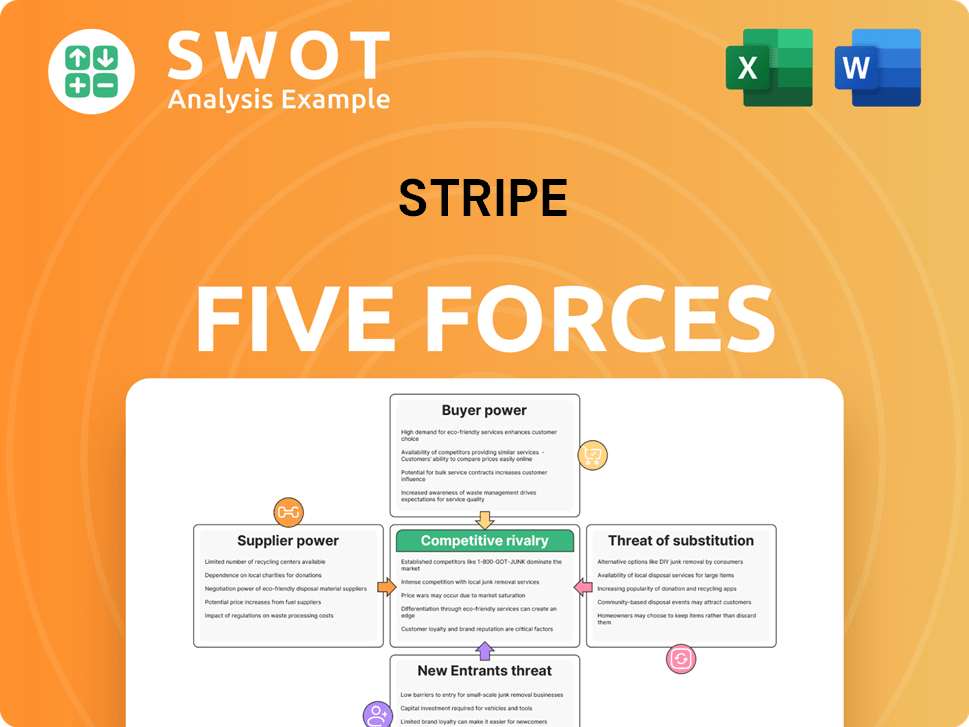
Related Blogs
- What are Mission Vision & Core Values of Stripe Company?
- What is Competitive Landscape of Stripe Company?
- What is Growth Strategy and Future Prospects of Stripe Company?
- How Does Stripe Company Work?
- What is Sales and Marketing Strategy of Stripe Company?
- What is Brief History of Stripe Company?
- What is Customer Demographics and Target Market of Stripe Company?
Disclaimer
All information, articles, and product details provided on this website are for general informational and educational purposes only. We do not claim any ownership over, nor do we intend to infringe upon, any trademarks, copyrights, logos, brand names, or other intellectual property mentioned or depicted on this site. Such intellectual property remains the property of its respective owners, and any references here are made solely for identification or informational purposes, without implying any affiliation, endorsement, or partnership.
We make no representations or warranties, express or implied, regarding the accuracy, completeness, or suitability of any content or products presented. Nothing on this website should be construed as legal, tax, investment, financial, medical, or other professional advice. In addition, no part of this site—including articles or product references—constitutes a solicitation, recommendation, endorsement, advertisement, or offer to buy or sell any securities, franchises, or other financial instruments, particularly in jurisdictions where such activity would be unlawful.
All content is of a general nature and may not address the specific circumstances of any individual or entity. It is not a substitute for professional advice or services. Any actions you take based on the information provided here are strictly at your own risk. You accept full responsibility for any decisions or outcomes arising from your use of this website and agree to release us from any liability in connection with your use of, or reliance upon, the content or products found herein.